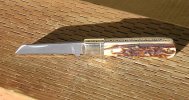Modoc ED
Gold Member
- Joined
- Mar 28, 2010
- Messages
- 14,377
Say a cutler is assembling knives and has all the parts necessary laid out on a table next to him. Everything is the same - blades from the same batch as well as the liners from the same batch, and the springs from the same batch etc.. As the cutler is progressing, on a whim, he chooses a spring at random and works it over with a file and assembles it into one of the knives he is working on. When finished assembling the knives, is the fileworked spring as strong as the springs in the other knives and is the fileworked knife as capable a user as the non-fileworked knives?
This picture is to illustrate a fileworked spring only. Nothing to do with pattern or manufacturer.

This picture is to illustrate a fileworked spring only. Nothing to do with pattern or manufacturer.


